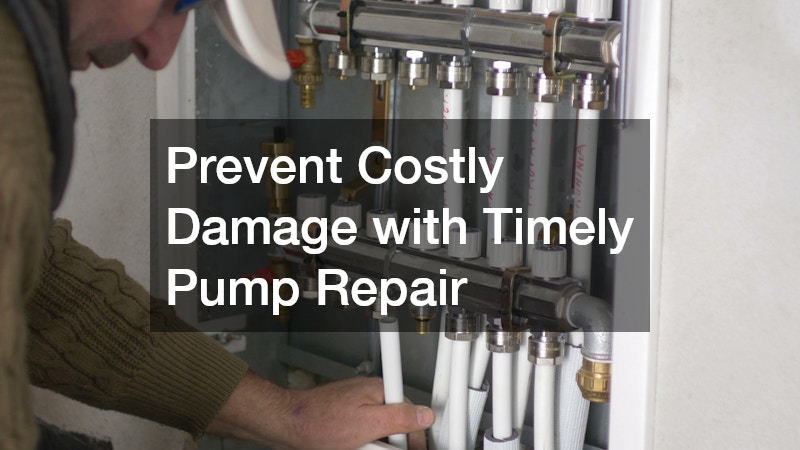Explore the critical importance of timely pump repair to prevent costly damage and ensure optimal performance of your pump systems. This guide addresses common concerns and provides actionable insights into maintaining and troubleshooting pump systems effectively. Timely maintenance is a proactive approach that not only addresses present issues but prevents future complications, preserving the efficiency and longevity of your pumping systems.
Recognizing Signs of Pump Wear
Understanding the indicators of pump wear is crucial for maintaining operational efficiency. Unusual noises, leaks, and reduced performance are critical signs that necessitate immediate inspection. These symptoms often precede more severe issues, making early detection a key aspect of maintenance strategy.
Unusual noises may indicate internal damage or loose components that could exacerbate if ignored. Leaks not only result in fluid loss but also can lead to environmental and safety hazards. Reduced performance, on the other hand, is often indicative of blockages or internal wear that needs to be addressed quickly to prevent system failure.
Establishing a Regular Inspection Schedule
Developing a routine maintenance timetable is fundamental to preventing unexpected pump failures. A well-devised schedule encompasses regular inspections based on manufacturer recommendations and operational demand. This ensures that potential issues are caught early, maintaining continuous operation and preventing costly downtimes.
Inspections should vary in frequency based on pump usage intensity and environmental conditions. High-usage systems may require monthly checks, while those operating in harsher conditions necessitate more frequent scrutiny. A tailored schedule considers these variables, ultimately saving on unnecessary repairs and ensuring longevity.
Utilizing Advanced Inspection Tools
Modern diagnostic tools play a pivotal role in identifying potential issues before they escalate into significant problems. Vibration analysis, thermal imaging, and ultrasonic testing are examples of advanced techniques that provide detailed insights into pump conditions. These tools enhance the ability to detect anomalies at early stages, offering a more scientific approach to maintenance.
Vibration analysis detects deviations in pump condition by monitoring oscillations, providing early warning signs of mechanical faults. Thermal imaging helps identify overheating components, often a precursor to failure. Ultrasonic testing, meanwhile, is effective in detecting leaks and tells-tale signs of cavitation and air ingress.
Mechanical Seal Failures
Mechanical seal failures are a prevalent issue in pump systems, primarily arising from wear or improper installation. Seals are critical in preventing fluid leakage, and their failure can lead to significant operational disruptions. Addressing seal problems promptly prevents escalation into broader system failures.
Common causes of seal failure include incorrect installation, misalignment, and thermal distortion. Quick detection and resolution of seal issues help prevent fluid contamination and ensure operational safety. Regular inspection of seals coupled with correct installation practices play a vital role in mitigating seal-related disruptions.
Impeller Wear and Damage
Impeller wear and damage significantly impact pump efficiency and longevity. Abrasive and corrosive fluids often accelerate impeller degradation, compromising flow and performance. Identifying wear early not only maintains operational efficiency but also prevents further damage to adjacent components.
Factors like pump cavitation or operating beyond recommended conditions often exacerbate impeller wear. Regularly inspecting and maintaining impellers prevent unexpected breakdowns and improve system reliability. Addressing wear immediately upon detection avoids costly replacements and operational delays.
Motor Overheating Issues
Motor overheating is a common problem that can lead to significant downtimes if not addressed promptly. Causes include overloading, inadequate cooling, and electrical faults, each requiring swift intervention to prevent damage. Early diagnosis and remediation ensure motors remain operational and mitigate the risk of system failure.
Preventative measures, such as ensuring proper ventilation and applying correct load levels, vastly reduce overheating occurrences. Regular monitoring and implementing fail-safes guard against excessive current loads and temperature extremes. Implementing these practices leads to longer motor life and reduced energy costs.
Enhancing Pump Efficiency and Performance
Regular repairs and maintenance play an essential role in enhancing pump efficiency and performance. Timely intervention can reduce energy consumption by ensuring each component operates seamlessly. By optimizing each part of the pump system, businesses can realize significant cost savings over time.
Enhanced efficiency translates to improved flow rates and consistent pressure levels, leading to better system outputs. Addressing minor issues proactively maintains consistent performance metrics and extends service intervals. This leads to fewer disruptions and maximizes the productive capacity of industrial operations.
Extending Pump Lifespan
Timely repairs contribute significantly to the longevity of pump systems. Addressing small issues before they escalate prolongs the service life of components, offering substantial cost savings on replacements. This proactive approach means companies can avoid the capital expenditure associated with acquiring new systems prematurely.
Adhering to manufacturer guidelines and refined maintenance protocols supports pump durability. Utilizing high-quality parts in repairs further extends pump service life, making operations more reliable and predictable. Implementing a robust maintenance culture ensures that pumps remain in prime condition longer.
Reducing Long-Term Maintenance Costs
Addressing issues early on significantly reduces long-term maintenance expenses. Proactive maintenance curtails the likelihood of extensive repairs, keeping maintenance budgets manageable. This approach enhances financial forecasting, allowing businesses to better allocate resources across operations.
Timely pump repair is essential to avoiding costly damage and ensuring your systems operate at their best. By understanding when and how to address repair needs, businesses can maintain efficient, reliable operations and save significantly on repair costs. Implementing a comprehensive maintenance strategy that marries proactive practices with advanced tools ensures long-term system health and operational success.

